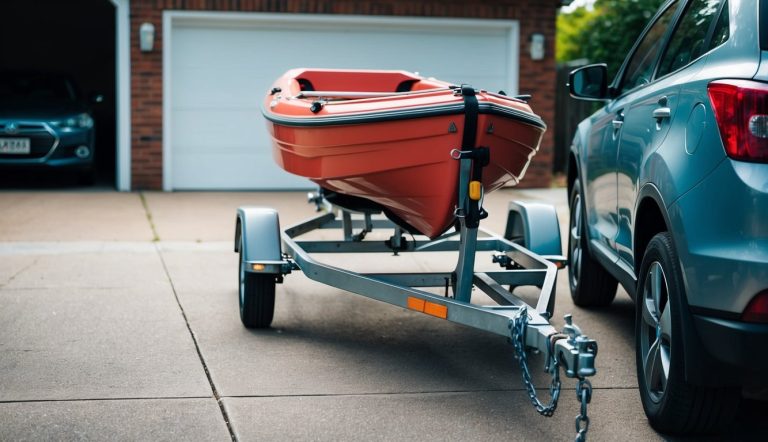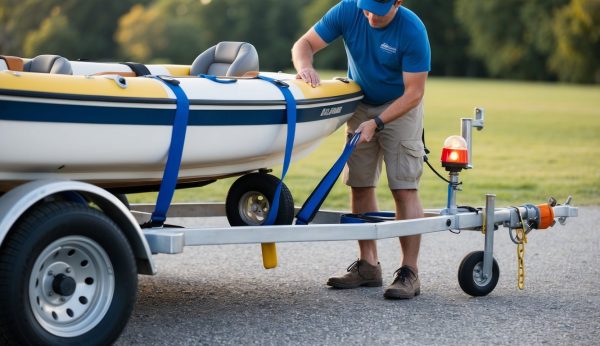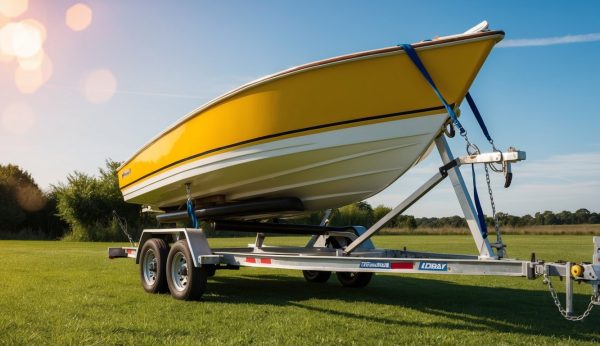Preparing Your Dinghy for Transport
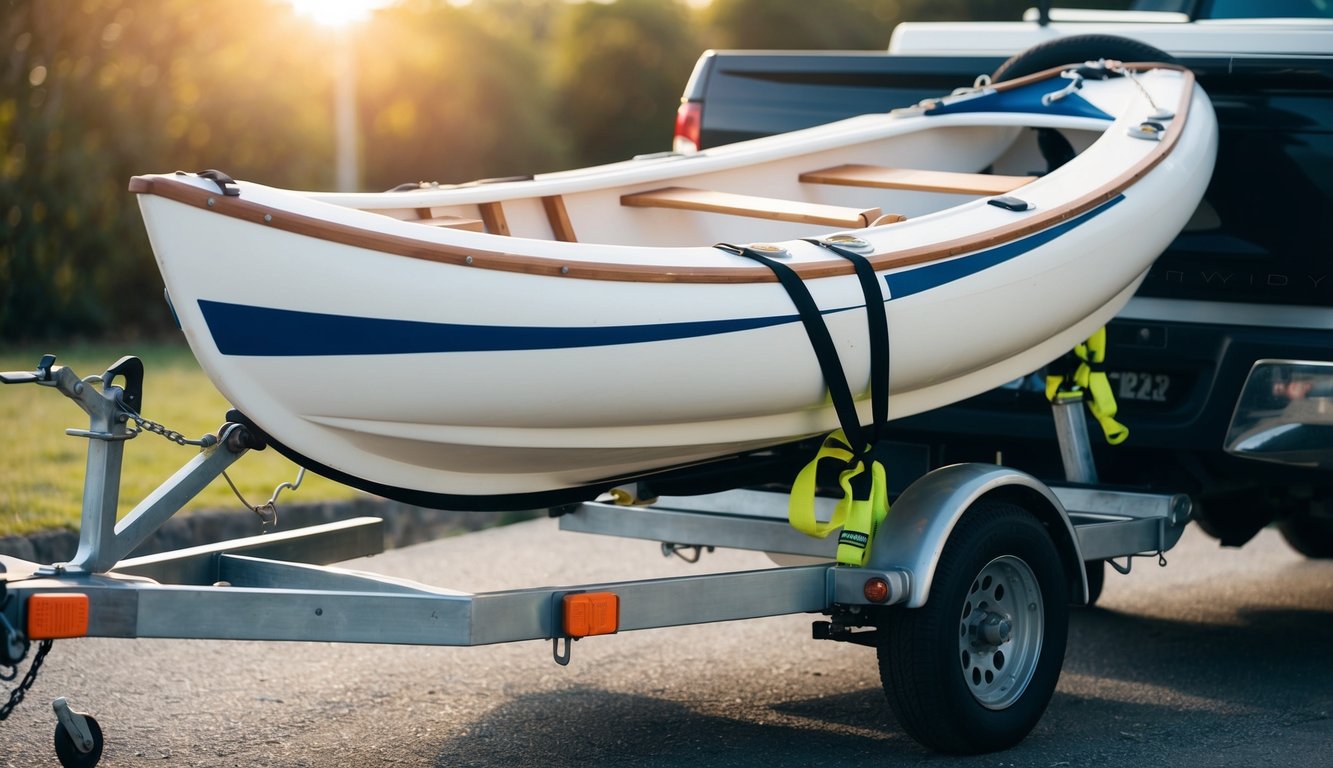
Proper preparation is essential before moving your dinghy. Taking time to secure and protect your boat will prevent damage and make the transportation process smoother.
Securing Loose Items
- Start by removing all removable equipment from your dinghy. This includes life jackets, paddles, anchors, and navigation tools. Store these items separately in waterproof containers or bags.
- Check for items that cannot be removed but might shift during transport. Use long and durable load straps to secure these items firmly to the boat structure. Pay special attention to seats, benches, and storage compartments.
- For inflatable dinghies, ensure all valves are tightly closed. Slightly deflate the tubes if you’ll be traveling in changing elevations or temperatures. This prevents over-expansion which can damage seams.
- Document your setup with photos before dismantling anything. This provides a helpful reference for reassembly later.
- Empty any water containers and drain bilge water completely. Excess water adds unnecessary weight and can cause instability during transport.
Protecting Sensitive Areas
- Cover your dinghy with a properly fitted boat cover or tarp to shield it from road debris, insects, and weather elements. Secure the cover tightly to prevent flapping that could cause abrasion damage.
- Use foam padding or cushioning material on vulnerable areas like the hull, gunwales, and transom. These areas are most susceptible to scratches and dents during loading and transport.
- For wooden dinghies, apply a thin coat of protective wax on exposed surfaces. This provides extra protection against moisture and dirt.
- If transporting on a trailer, place protective material between the boat and all contact points with the trailer. Check that your bunks or rollers are clean and properly positioned.
- For inflatable dinghies, ensure no sharp objects can contact the material. Cover any exposed metal parts on your vehicle rack or trailer that might puncture the boat.
Ensuring Accessibility
- Arrange tie-down points so they’re easy to check and adjust during your journey. You should be able to inspect all straps without removing the entire cover or climbing underneath the trailer.
- Keep essential tools accessible for quick adjustments on the road. This includes a pump for inflatable dinghies, wrenches for trailer adjustments, and extra straps.
- Label all parts and connections if you’ve disassembled components. This makes reassembly much simpler when you reach your destination.
- If using a trailer, ensure brake lights and turn signals remain visible. Never allow your boat cover or tie-downs to obscure these critical safety features.
- Place a checklist in your vehicle with all the steps for loading, securing, and unloading your dinghy. This helps prevent overlooking critical steps, especially when you’re tired after a long day on the water.
Choosing the Right Transport Method
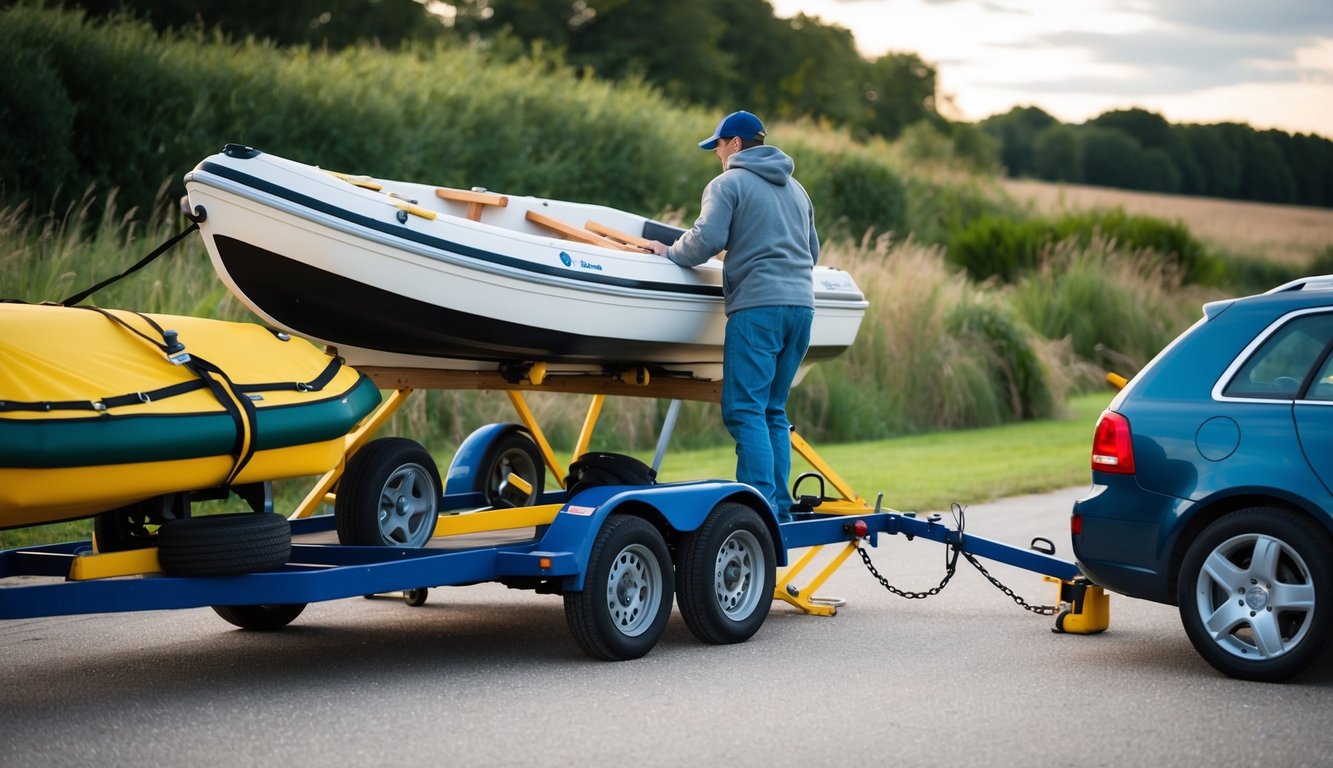
Selecting the appropriate method to move your dinghy depends on the boat’s size, your budget, and the distance it needs to travel. Each transport option comes with different requirements and advantages.
Trailering a Dinghy
- Trailering is often the most economical way to transport a dinghy. You’ll need a properly sized trailer that matches your dinghy’s weight and dimensions.
- When securing your boat for trailering, use at least two tie-down straps—one at the bow and one at the stern. Make sure the winch strap is tight and secured with a safety chain.
- Check your trailer’s tire pressure before departure and inspect the lights to ensure they’re working properly. Most states require trailer brakes for loads over 3,000 pounds.
- Remember to remove or secure loose items inside the dinghy to prevent shifting during transport. A proper cover will protect your dinghy from road debris and weather during the journey.
Towing Behind a Vehicle
For shorter distances on water, towing your dinghy behind another vessel is an option. This method requires proper towing equipment including a strong tow line designed for marine use. Keep the tow line length between 1.5 to 2 times the length of the towing boat in calm waters. In rougher conditions, a longer line helps the dinghy ride better in the wake.
Important towing safety tips:
- Always use a bridle attachment rather than a single point
- Keep speed moderate (usually under 10 knots)
- Never tow in severe weather conditions
- Check the tow line regularly for wear
Monitor the dinghy frequently during towing to ensure it’s tracking properly and not taking on water.
Hiring a Professional Boat Transport Service
When moving your dinghy long distances, professional transport services offer convenience and expertise. These companies have specialized equipment and insurance for boat transportation. When choosing a boat transporter, verify their credentials and insurance coverage. Request quotes from multiple providers to compare rates and services.
Professional transporters typically offer two main options:
- Overland transport – Your dinghy travels on a trailer
- Piggyback shipping – Small boats transported on larger vessels
Prepare your dinghy by removing personal items, disconnecting batteries, and securing or removing electronics. Take photos before transport to document your boat’s condition. Most services include basic insurance, but consider additional coverage for valuable boats. Typical transport costs range from $1.50 to $3.50 per mile depending on size and distance.
Cost-Effective Tips for Dinghy Transportation
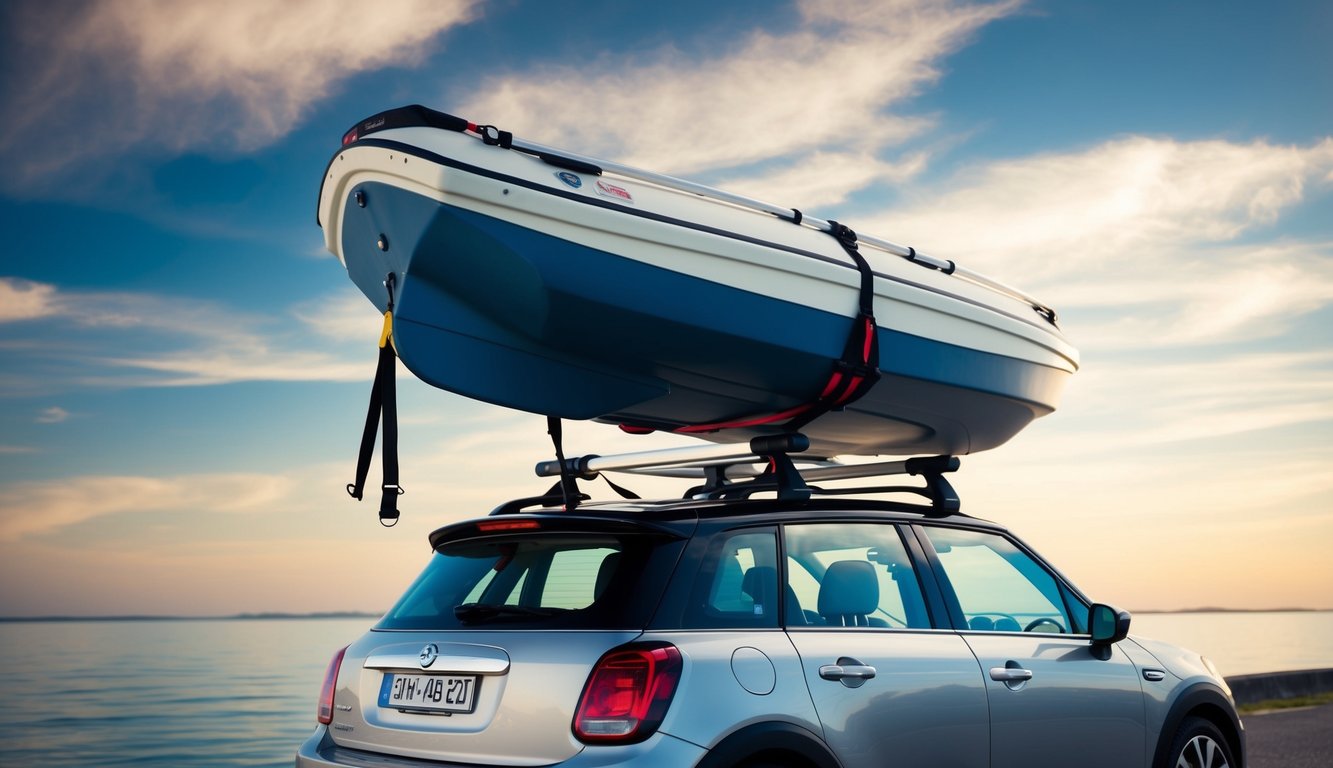
Moving your dinghy doesn’t have to drain your wallet. Smart planning and knowledge of available options can significantly reduce transportation costs while ensuring your boat arrives safely.
Comparison Shopping for Services
- Getting quotes from multiple boat transporters is essential before making a decision. Different boat shipping companies offer varying rates and service levels. Request written estimates that include all fees to avoid surprise charges later.
- Online platforms make it easy to compare multiple transporters simultaneously. Look beyond the base price and consider insurance coverage, delivery timeframes, and company reputation.
- Check if companies offer price matching. Some transporters will match or beat competitors’ quotes for similar services, potentially saving you substantial money.
- Remember that the cheapest option isn’t always the best value. Balance cost against reliability, experience, and safety record when making your final choice.
Considering Off-Season Transport
- Timing your dinghy transport strategically can lead to significant savings. Boat shipping demand typically peaks during spring and summer months when most people are moving their vessels to water.
- Winter and fall generally offer lower transportation rates as companies compete for fewer customers. You might save 15-30% by scheduling during these off-peak periods.
- Weather considerations remain important during off-season transport. While winter transport costs less, you’ll need to ensure your dinghy has proper protection against harsh conditions.
- Many transport companies offer promotional discounts during slower seasons. Ask specifically about seasonal specials when requesting quotes.
Exploring Shared Transport Options
- Sharing transportation costs with other boat owners can dramatically reduce your expenses. Many transporters offer consolidated shipping options where multiple small boats are moved together.
- Look for online forums and social media groups where dinghy owners coordinate shared transport. These community-organized options often cost significantly less than individual shipping arrangements.
- Consider if your transport timeline is flexible. Shared transport typically requires coordination with other schedules, which might mean waiting for the right opportunity.
- Another option is finding a car with a hitch kit to tow your dinghy yourself. Most dinghies are lightweight enough that almost any vehicle can pull them, making this a very cost-effective solution if you’re comfortable with DIY transport.
Loading and Unloading Best Practices
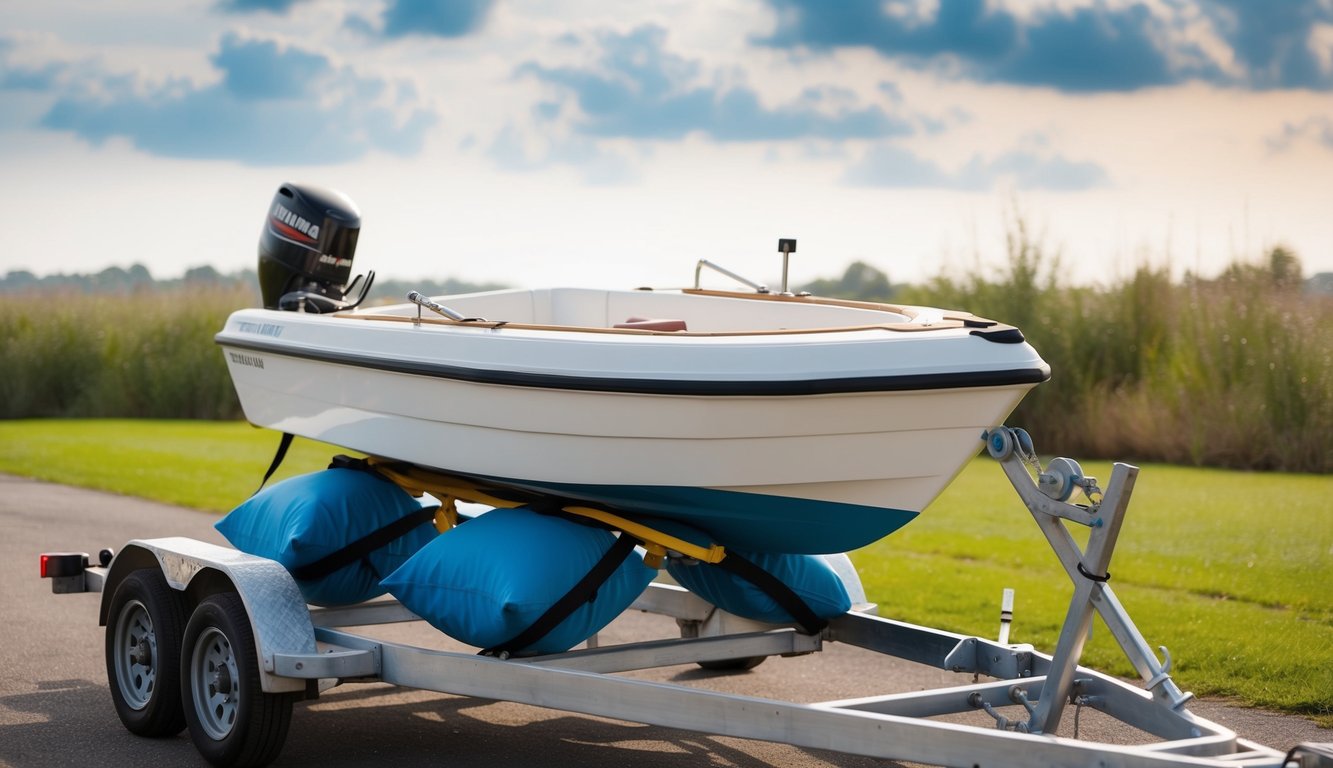
Proper loading and unloading practices are essential to protect your dinghy during transport. The right equipment and careful handling can prevent damage and ensure safety for both you and your boat.
Using the Proper Equipment
Before loading your dinghy, gather all necessary equipment to make the process smooth and safe. Ratchet straps are essential for securing your boat to a trailer or roof rack. Place protective foam between the straps and hull to prevent scratches and pressure damage.
For loading onto a boat ramp, use:
- Trailer with proper tie-downs
- Non-slip gloves for better grip
- Wheel chocks to prevent rolling
- Guide poles for alignment assistance
Inspect the ramp conditions before you begin the loading process. Ensure your trailer and boat are properly aligned to avoid complications. Having a loading checklist helps you remember all critical steps. Take your time when winching the dinghy onto the trailer. Rushing increases the risk of damage and personal injury.
Minimizing Risk of Damage
To protect your dinghy during the loading and unloading process, secure all loose gear and equipment. Remove or tie down any items that could shift and cause damage.
For sensitive or valuable items:
- Use dry bags for electronics and valuables
- Pack a soft-sided cooler for temperature-sensitive items
- Apply padding to fragile components
Drain all fluids including water and fuel before loading to reduce weight and prevent spills. This makes the dinghy lighter and easier to handle. When loading onto a car roof, attach the mast to the bottom of the trailer or secure it separately. This prevents it from swinging or causing wind resistance during transport. Check all tie-downs twice before moving. Even a short trip can loosen straps if they’re not properly secured.
Protecting Your Dinghy During Transit
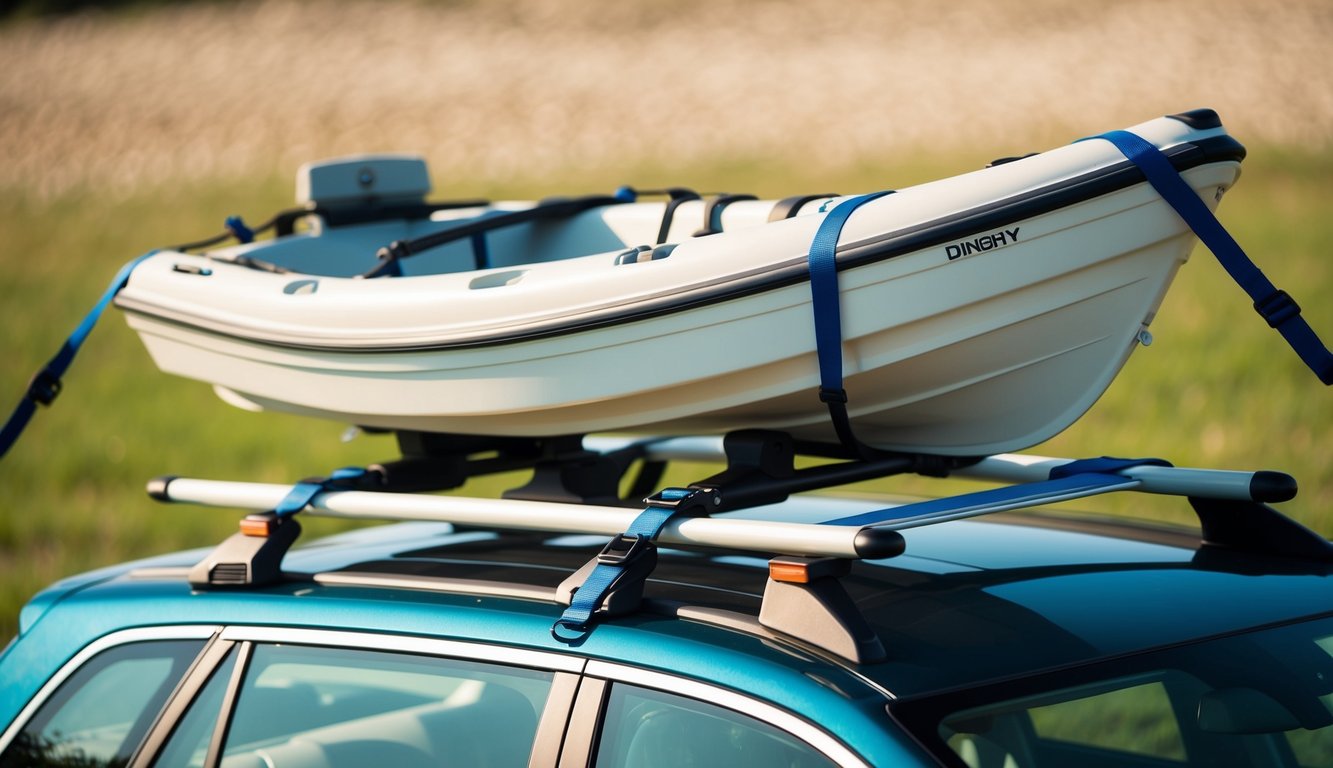
Proper protection of your dinghy during transportation helps prevent damage and extends its lifespan. Taking preventive measures against weather elements and understanding your insurance coverage are essential steps before hitting the road.
Weatherproofing for Journey
- When transporting your dinghy, always use a high-quality cover designed specifically for your boat model. This helps shield it from rain, debris, and UV damage during transit.
- For inflatable dinghies, consider using towels or flat straps at contact points with your vehicle or trailer to reduce abrasion. These protective layers prevent chafing that could damage the material.
- Secure any loose items inside the dinghy to prevent movement that might cause internal damage. Remove detachable components like seats and oars, and pack them separately with padding.
- Apply a thin layer of protectant to rubber or PVC surfaces before long journeys. This helps prevent cracking from exposure to the elements.
- Make sure the cover is taut and properly secured to prevent water pooling or wind damage. A properly fitted cover provides crucial protection during transit.
Insurance and Liability Considerations
- Check that your existing boat insurance covers transportation incidents. Many basic policies only cover on-water accidents, not transit damage.
- Consider adding a specific trailer/transit rider to your policy if you frequently transport your dinghy. This typically costs $50-100 annually but provides valuable protection.
- Document your dinghy’s condition before transport with dated photos. This evidence is invaluable if you need to file an insurance claim later.
- Verify liability coverage in case your dinghy becomes detached during transit and causes damage or injury. This protection is separate from physical damage coverage.
- When crossing state lines, check if different insurance requirements apply. Some states have stricter liability requirements for towed watercraft.
- Keep your insurance documents easily accessible during transport. Having this information readily available speeds up the process if an incident occurs.
